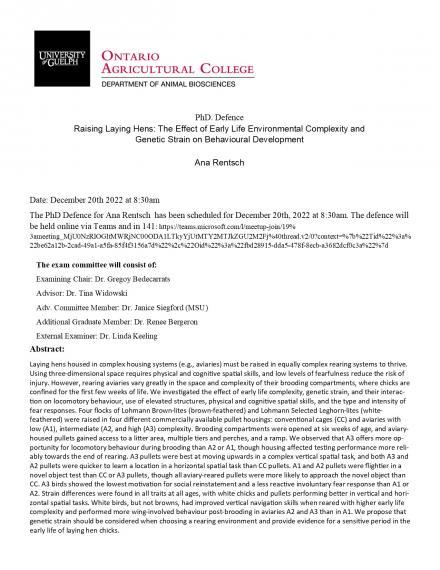Ana Rentsch's PhD Defence
Date and Time
Location
Room 141 and Teams: https://teams.microsoft.com/l/meetup-join/19%3ameeting_MjU0NzRlOGItMWRjNC00ODA1LTkyYjUtMTY2MTJkZGU2M2Fj%40thread.v2/0?context=%7b%22Tid%22%3a%22be62a12b-2cad-49a1-a5fa-85f4f3156a7d%22%2c%22Oid%22%3a%22fbd28915-dda5-478f-8ecb-a3682dcf0c3a%22%7d

Details
Laying hens housed in complex housing systems (e.g., aviaries) must be raised in equally complex rearing systems to thrive. Using three-dimensional space requires physical and cognitive spatial skills, and low levels of fearfulness reduce the risk of injury. However, rearing aviaries vary greatly in the space and complexity of their brooding compartments, where chicks are confined for the first few weeks of life. We investigated the effect of early life complexity, genetic strain, and their interaction on locomotory behaviour, use of elevated structures, physical and cognitive spatial skills, and the type and intensity of fear responses. Four flocks of Lohmann Brown-lites (brown-feathered) and Lohmann Selected Leghorn-lites (white-feathered) were raised in four different commercially available pullet housings: conventional cages (CC) and aviaries with low (A1), intermediate (A2, and high (A3) complexity. Brooding compartments were opened at six weeks of age, and aviary-housed pullets gained access to a litter area, multiple tiers and perches, and a ramp. We observed that A3 offers more opportunity for locomotory behaviour during brooding than A2 or A1, though housing affected testing performance more reliably towards the end of rearing. A3 pullets were best at moving upwards in a complex vertical spatial task, and both A3 and A2 pullets were quicker to learn a location in a horizontal spatial task than CC pullets. A1 and A2 pullets were flightier in a novel object test than CC or A3 pullets, though all aviary-reared pullets were more likely to approach the novel object than CC. A3 birds showed the lowest motivation for social reinstatement and a less reactive involuntary fear response than A1 or A2. Strain differences were found in all traits at all ages, with white chicks and pullets performing better in vertical and horizontal spatial tasks. White birds, but not browns, had improved vertical navigation skills when reared with higher early life complexity and performed more wing-involved behaviour post-brooding in aviaries A2 and A3 than in A1. We propose that genetic strain should be considered when choosing a rearing environment and provide evidence for a sensitive period in the early life of laying hen chicks.